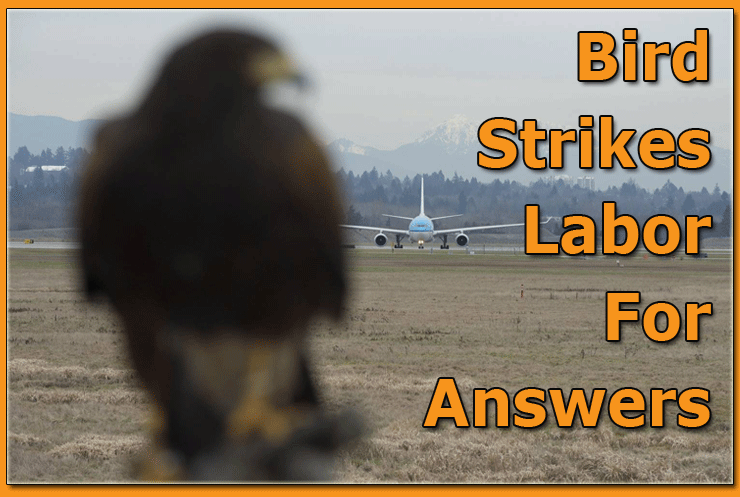
Technology has given aviation so many things.
Today, more people can fly than ever before, in larger, quieter planes
with all the luxurious amenities of the 21st century—telecommunications,
Internet, personal TV screens. So much is available in-flight, it’s
almost hard to see further ahead in time, to imagine what else might be
possible.
 Paradoxically,
the business of flying still faces some age-old problems that seem so
simplistic in nature it’s difficult to comprehend why we haven’t
yet solved them. Most frighteningly, bird strikes. Paradoxically,
the business of flying still faces some age-old problems that seem so
simplistic in nature it’s difficult to comprehend why we haven’t
yet solved them. Most frighteningly, bird strikes.
The most visible and perhaps most famous
bird strike occurred six years ago, on January 15, 2009, when a flock
of Canada geese were ingested in both engines of US Airways Flight 1549
as it debarked LaGuardia Airport in New York City. Thanks to the quick
thinking of Captain Chesley Sullenberger, the 155 passengers on board
were spared when he expertly ditched the Airbus 320 into the Hudson River.
Unfortunately, bird strike incidences are more common than one might think.
According to the FAA, “wildlife strikes have killed more than 255
people and destroyed over 243 aircraft since 1988.” The threat of
birdstrikes is only growing, due to “increasing populations of large
birds and increased air traffic by quieter, turbofan-powered aircraft.”
Between 1990 and 2013, there were 142,603 strikes, with strikes increasingly
“6.1 fold from 1,851 in 1990 to a record 11,315 in 2013.”
During that same time period, “503 species of birds, 42 species
of terrestrial mammals, 19 species of bats, and 15 species of reptiles
were identified as struck by aircraft,” with “waterfowl, gulls,
and raptors” dealing the most damaging strikes.
 |
Thus far, methods to deal with birdstrikes have
fallen woefully short of technological advancements. While
Occam’s Razor surely applies in most cases, when dealing with birdstrikes,
the simplest method has often proven ineffective. The ground up approach
is quite popular, with airports removing ponds and seed-bearing trees
to discourage foraging animals, which in theory should discourage their
predators (i.e., raptors). According to an article in USA Today, Salt
Lake City International Airport effectively replaced 1 million square
feet of grass with gravel to create an inhospitable zone for small creatures.
“The idea behind that is removing
the prey base, particularly the rodents that attract large-body raptors,”
says Gib Rokich, Salt Lake airport's wildlife manager. “It goes
all the way down to midges to grasshoppers to army worms.
“I look at it as a restaurant —
we've had a terrific restaurant here for raptor food. The diners include
red-tailed hawks, Northern Harriers, Peregrine falcons, barn owls, and
great-horned owls.
“They readily came here to eat to
their heart's content. We're trying to close the restaurant,” says
Rokich.
Salt Lake City also employs pigs, which
destroy nesting habitats and feast on fowl eggs. “The pigs work
great,” Rokich says. “The gulls see the pigs on the island
and relocate elsewhere.”
Southwest Florida International Airport
went a step further and began employing dogs to ward off the wading birds
attracted by rainwater pools that form on the airport’s flat terrain.
Sky the Border Collie lives with airport handlers and works seven days
a week, scouring areas too dense for vehicles and humans. Whereas previous
methods included various noisemakers like ‘shell crackers’
(fireworks blasted from a shotgun) and ‘screamers’ (bottle
rocket-like devices fired from a pistol), Sky is a deterrent to which
the birds simply cannot grow accustomed.
“The dog is a natural predator—they
never get used to her,” said James Hess, airside operations supervisor
for Southwest Florida International.
It’s clear that this supposedly simple
problem requires more than a simple solution, and that is where technology
enters the conversation. According to an article in The Economist, “the
air forces of several countries have used radar to track birds”
for over a decade. Fortunately, the methodology employed by the military
sector is now being considered for civilian airports.
Yossi Lesham of Tel Aviv University in Israel
combines several modes of observation to gather information on flocking
birds. Through a mix of drones, powered gliders, ground-based bird watchers,
and radar, Dr. Leshem was able to decipher radar blips and identify them
ornithologically. His system can identify and follow “individual
birds that weigh as little as ten grams and are as far away as 20km.”
His work has inspired others to track birds via radar, and equipment has
been developed for the purpose. Canadian firm Accipiter Radar Technologies
created the eBirdRad radar unit, which can track over 100 targets all
at once at a range of at least 11km and up to an altitude of 1km. The
eBirdRad system is currently being tested at “JFK Airport in New
York, O’Hare Airport in Chicago, and Seattle-Tacoma  Airport
in Washington state, in an experiment run by the University of Illinois
at Urbana-Champaign and sponsored by the FAA,” according to The
Economist. Similar systems are being developed worldwide, but there seems
to be a troubling resistance and reluctance to adopt the radar method.
Dr. Lesham believes the reluctance is due to “bureaucratic inertia.”
American firm DeTect created “Merlin,” a radar detection system
currently installed at various American air force bases as well as several
bases worldwide. Airport
in Washington state, in an experiment run by the University of Illinois
at Urbana-Champaign and sponsored by the FAA,” according to The
Economist. Similar systems are being developed worldwide, but there seems
to be a troubling resistance and reluctance to adopt the radar method.
Dr. Lesham believes the reluctance is due to “bureaucratic inertia.”
American firm DeTect created “Merlin,” a radar detection system
currently installed at various American air force bases as well as several
bases worldwide.
DeTect’s General Manager Gary Andrews
thinks the reasoning against radar is slightly more sinister.
According to The Economist, he
believes the USDA is threatened by radar systems because they are paid
by local authorities to control birds by traditional methods. This, despite
the USDA itself recommending “new technologies such as the use of
bird-detecting radar…should be pursued more vigorously.”
If bird strikes are as great a threat to
air travel as they seem to be, it shouldn’t matter how we rid ourselves
of this avian problem, only that we do so, and quickly. Later we can think
on the irony of these beautiful animals—how they began as the source
inspiration for our journey to the skies, and rapidly became a deadly
obstacle to our flight.
Flossie Arend
|





